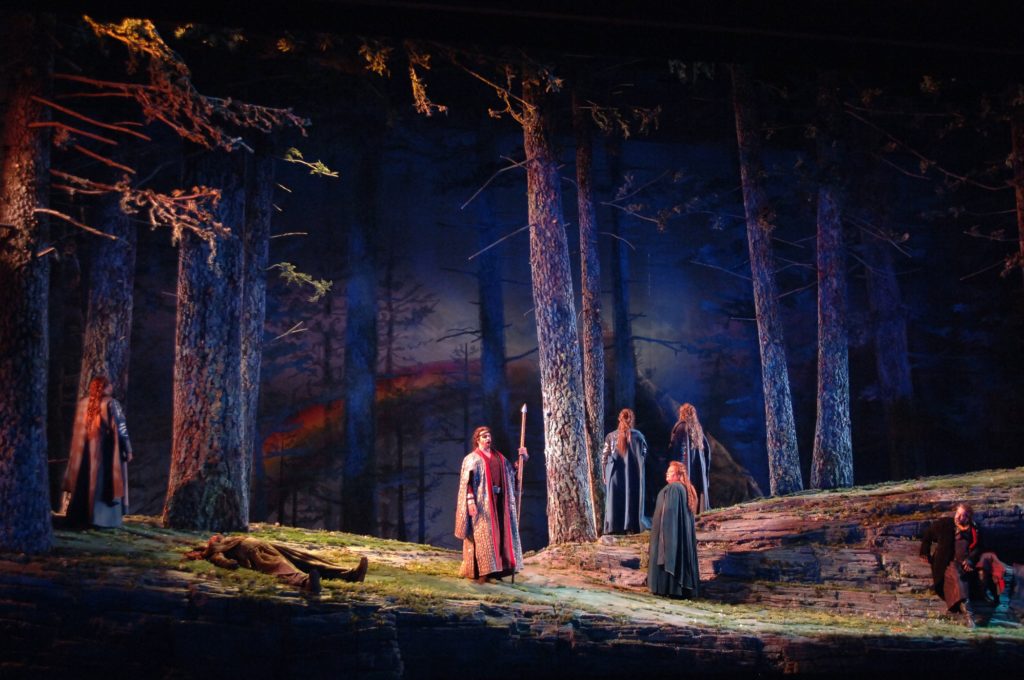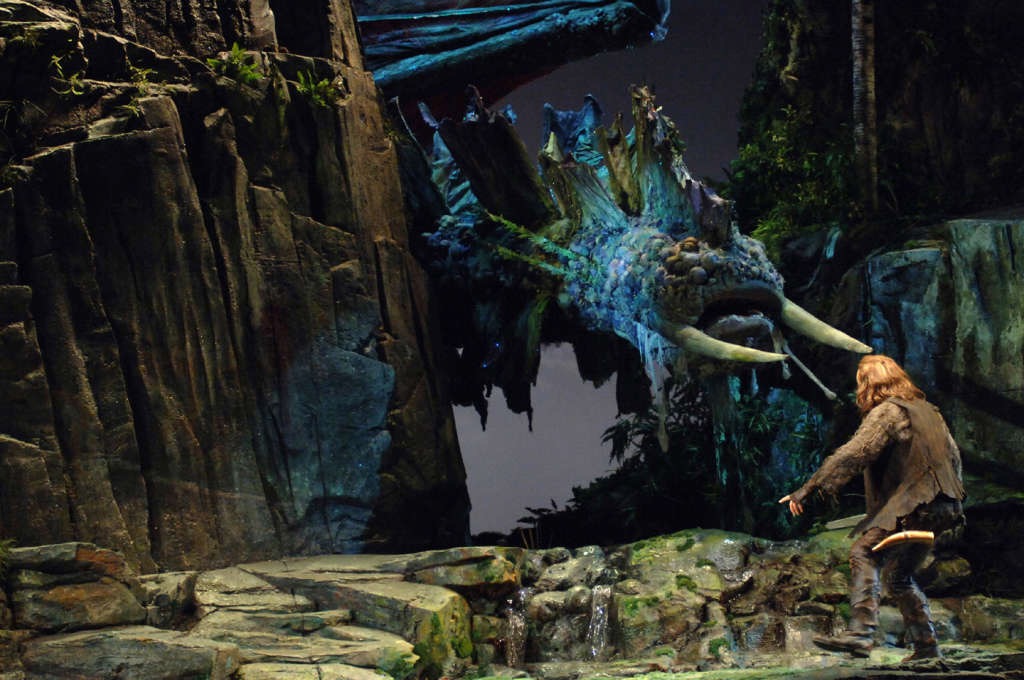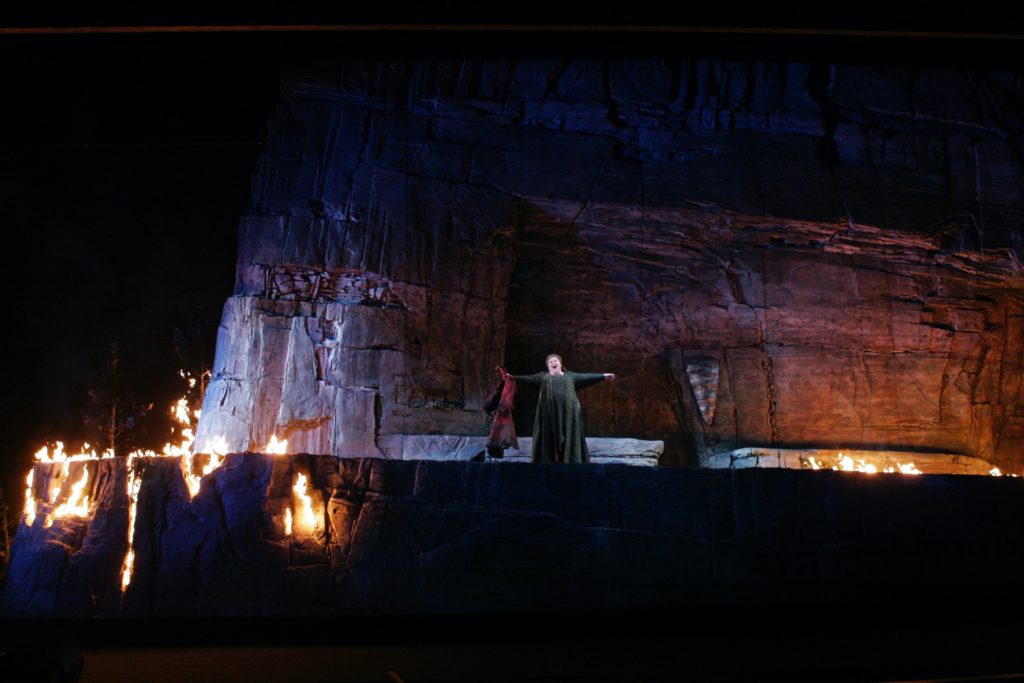Archive for October 2005
Seattle’s “Der Ring Des Nibelungen” — in 2005
DER RING DES NIBELUNGEN
Seattle Opera’s “Green” Concept Places Nature in Conflict with Man and the Gods
By David Gregson, October 25, 2005
Thanks to J.R. Tolkien and the trilogy of films made from his popular The Fellowship of the Ring novels, Wagner’s Der Ring des Nibelungen is no longer the planet’s most widely known epic art work dealing with a magical ring that corrupts and destroys even as it confers limitless power upon its owners; nevertheless, neither the films nor Tolkien’s books themselves come close to equaling the moral and philosophical complexity of Wagner’s four-part music drama with its depth of characterizations, richness of symbolism, and inspired, incomparable music.
Of course, unlike the Tolkien films, Wagner’s Ring requires a substantial investment of time and effort and money on the part of the spectator: one has to purchase tickets for the performances and usually travel to another town and find lodging for about a week (or more in some cases); and all but the most fanatical and jaded “Ringheads” truly need to prepare for the 17 hours of sitting and listening that Wagner expects. That means attending lectures, reading biographies and musical analyses, familiarizing oneself with many sections of the score and Wagner’s system of leitmotifs — and ultimately, preparing to suspend one’s disbelief and sense of the ridiculous. And if one knows the Ring from recordings, one must also be prepared for singers who do not meet expectations and for theatrical stagings that fail to equal the fantastical visions Wagner’s music conjures so vividly in the mind.
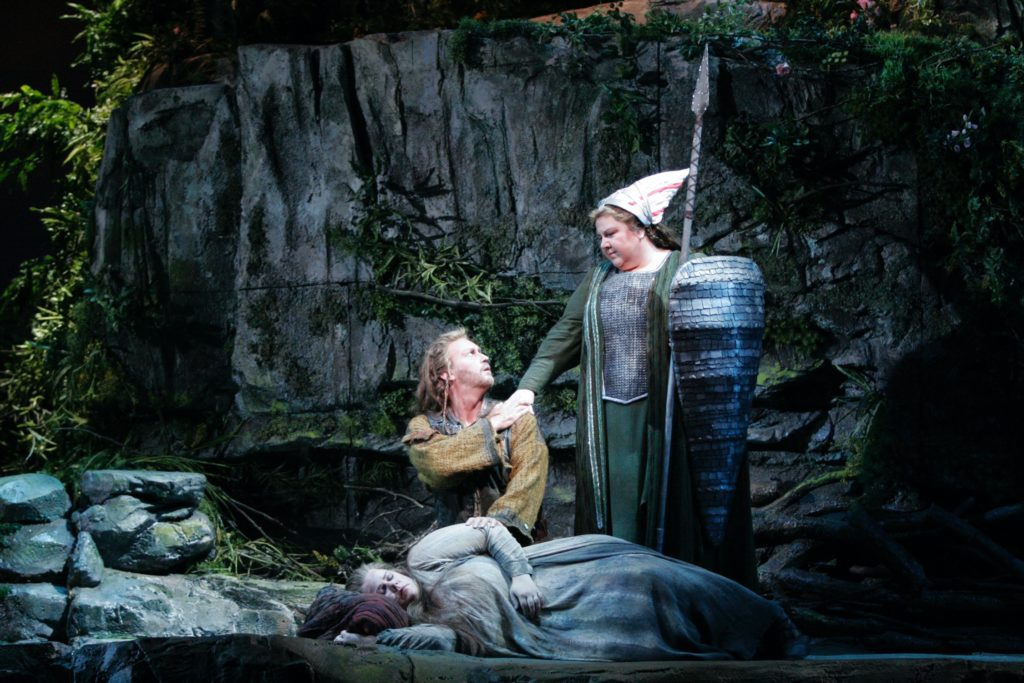
Margaret Jane Wray (Sieglinde), Richard Berkeley-Steele (Siegmund), and Jane Eaglen (Brünnhilde) in Wagner’s Die Walküre, 2005 © Chris Bennion
One reason Wieland and Wolfgang Wagner drifted towards abstract, non-literal mountings of the Ring at Bayreuth is the notion that nothing a theatrical producer can put on stage could possibly reproduce Wagner’s world of gods, dwarfs, giants, mermaids, warrior maidens, flying horses, magic fires, dragons, physical metamorphoses, rainbow bridges and other wonders. It’s true that Wagner fires the imagination with visions that defy adequate stage representation – and perhaps opera companies should just have everyone don dresses and tuxedoes and do the whole damn thing as an oratorio. But, that would indeed be far from the “master’s” original intentions, so it’s always a delight when some daring company — in this case the Seattle Opera — goes as far as it can to give us something along the lines of what the composer wanted.
The current production was seen last when it was first performed in Seattle in 2001. It is the third of a series of Ring productions, the first (now called Ring I) being unveiled in 1975 and revived in 1984, while Ring II was given in 1986 and 1995. Ring III is already famous as “the green Ring” because of a large number of elaborately forested sets that look for all the world like postcard views of actual Pacific Northwest nature trails not too far from Seattle itself. But there are, in fact, some sets that look more like slices of Bryce Canyon or Canyonlands, those pinkish-brown wonders in Utah’s National Parks. This Ring is also green in that the cyclical story takes us from a state of innocent, undisturbed nature (at the bottom of a greenish Rhine river), through the corruption and destructive activities of Earth’s various denizens (Walsungs, Gibichungs, giants, dwarfs, and gods), and ultimately back to exactly where we began — although in this production the final tableau is not the Rhine but the Pacific Northwest forests reappearing in their unpopulated, virginal state.
Despite this and several other scenic deviations from Wagner’s original intentions, Thomas Lynch’s production designs are frankly literal to the highest degree possible. We got real magic fire, an elaborate dragon, invisibility and transformation effects, a traversable rainbow bridge, ravens and a forest bird, and even a real Grane – although the latter (Brünnhilde’s horse) was employed sparingly. This was definitely a Ring for those who “want to see something,” although there were no flying horses this time around. They were a popular feature of Ring II.
All of Cycle One was extremely well conducted by Robert Spano of the Atlanta Symphony Orchestra, but the fact that he is new to the Ring showed here and there throughout the 17 hours of music. Several sections in the four operas lacked the dramatic tension I was hoping for, but in the all-important long run, his work was highly impressive. Usually Spano delivered the goods. He may have dwelled too long on some delicate orchestral details, but these stretches were revelatory (at least to these ears), and while the Seattle orchestra could never be fairly compared to that of the Met (with its nearly flawless brass section, among other things), one would have to say it truly rose to the demands of the occasion. I cannot imagine too many Wagnerians were disappointed. Spano was also blessed with an especially fine roster of singers in which there were virtually no weak performers.
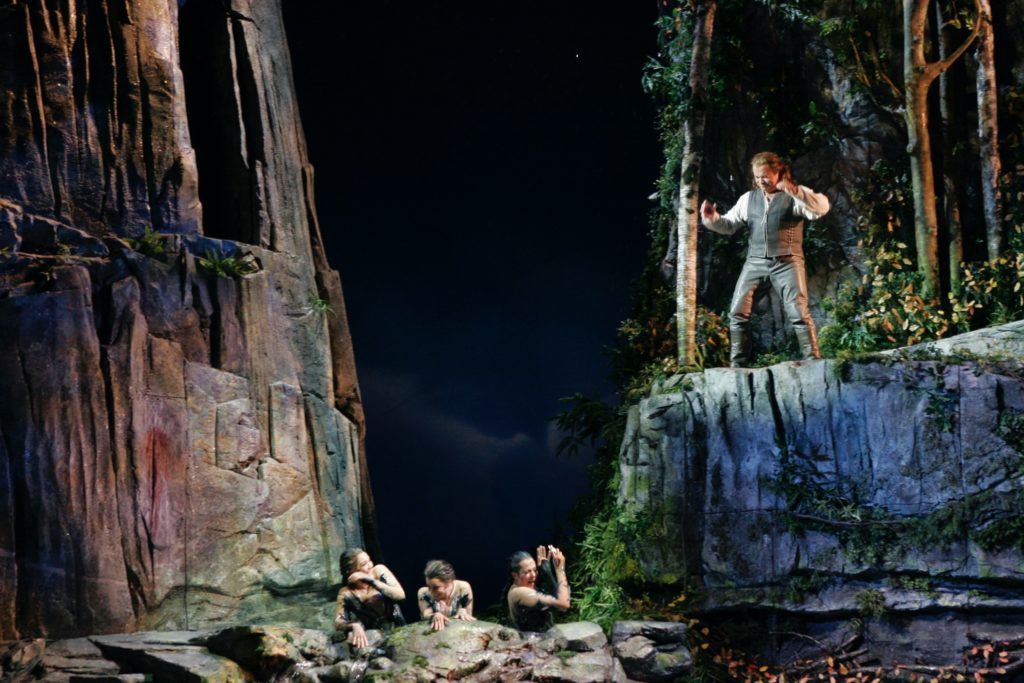
Jennifer Hines (Flosshilde), Wendy Hill (Woglinde), Mary Phillips (Wellgunde), and Alan Woodrow (Siegfried) in Wagner’s Götterdämmerung, 2005 © Chris Bennion
Where next to give credit in an artistic effort of such magnitude is easy: stage director Stephen Wadsworth. It is evident that he works with actors very well. Matters of overweight ladies aside (and there were more than a few of those!), every character seemed convincing in his or her part. Indeed, Wadsworth took the trouble to give every single Valkyrie maiden a distinct personality. At the moment in Die Walküre when Brünnhilde’s warrior sisters are bidding her farewell, each one had a distinct reaction: some were glad to get rid of her, others tearfully embraced her, and at least one seemed to be unable to make up her mind just how she felt. Needless to say, with Wadsworth’s commitment to nearly insignificant details of this sort, he lavished attention on the principals and got the greatest dramatic commitment possible of out each of them.
How innovative was Wadsworth? How true to the “master’s” intentions? Well, surprisingly, this Ring remained close to Wagner’s own stage concepts most of the time – something that cannot be said of most Ring productions today, especially in Europe where “director’s theater” still rages. Wadsworth even allows us to see the gods burn up in Götterdämmerung. There they all were, sitting around, waiting for the end with all those flammable logs from the World Ash Tree stacked up around them. Loge even lighted a match, so to speak. I guess all of the folks from Rheingold had to come back and wait around for this final scene. What a midnight party! (And I wonder if they got paid for overtime!)
Elsewhere Wadsworth dreamed up stage business I have never seen before. In Rheingold, Wotan (Greer Grimsley) and Fricka (Stephanie Blythe) smooched and kissed and clearly were in love with one another. And Wotan, whose single roving eye is mentioned in the super-titles, even gave Erda (Ewa Podles’) a few warm embraces when she emerged from her hole in the ground to urge him to “Watch out!” Well, Wotan has in fact sired a whole number of the Ring’s characters from Erda, so why wouldn’t he give her a few affectionate hugs? I enjoyed this touch. Wadsworth also gave Fricka a prominence seldom seen: She appeared at the end of the second act of Walküre so that Hunding (Stephen Milling) could kneel at her feet, something Wotan orders him to do in the text.
It would be impossible to praise Blythe’s Fricka too highly. Vocally she seemed so strong (as did the superb Sieglinde of Margaret Jane Wray) that Jane Eaglen’s sound paled in comparison. As Brünnhlde, Eaglen displayed a blazing top, but as the notes descended from the upper range, they decreased in their ability to project. It was a bit as if a volume control were being turn down. I sometimes cupped my ear to hear. But Blythe and Wray displayed equal strength and beauty of tone from one end of the scale to the other.
I think Grimsely, by the way, may be one of the best Wotans around and may soon set the standard in this country that has been maintained for so many years by James Morris. And before I allow Hunding to go to his fate, let me say he thoroughly impressed as a villainous heavy with a big heavy sound. As for Podles, when you hear this loud, deep contralto, you really believe that Mother Earth is talking.
Normally I find the first two acts of Siegfried an awful trial, and I have often told friends I think it is the ugliest opera ever written. Much of what makes it ugly, though, is a screaming Mime and a Siegfried who is struggling vocally. Thank heavens for the Mime of Thomas Harper: This singer eschewed the usual nasal sound and sang like a human being. He even managed to generate a certain amount of sympathy, whether this is appropriate or not! And while Alan Woodrow looks little like the youthful superhero of our imagination, he sang both of the final Ring operas with surprising musicality, superb stamina – and he even brought off the impossible high C in the hunting scene of Götterdämmerung. Usually it’s the Siegmund (in Walküre) that makes the greater impression, but Richard Berkeley-Steele seemed to lack a certain – “I don’t know what” as the French translates in English – heroic, ringing quality. I prefer Domingo’s recent achievements in this part.
During Cycle One, the terrific Hagen, Gidon Saks, pleaded upper respiratory problems, but he was smashing anyway, and his scene with Alberich, the marvelous Richard Paul Fink, was truly memorable. Other standouts included such fine performances as the Gunther of Gordon Hawkins, the Gutrune of Marie Plette, and the Waltraute of Nancy Maultsby.
There are perhaps better Rings on classic recordings, but I’m afraid those people are not around anymore. This Seattle effort is probably as good as it gets these days.
DER RING DES NIBELUNGEN
DAS RHEINGOLD
Wotan — Greer Grimsley
Loge — Peter Kazaras
Alberich — Richard Paul Fink
Mime — Thomas Harper
Fricka — Stephanie Blythe
Erda — Ewa Podles
Donner — Gordon Hawkins
Froh — Thomas Rolf Truhitte
Fasolt — Stephen Milling
Fafner — Gidon Saks
Freia — Marie Plette
Woglinde — Wendy Hill
Wellgunde — Mary Phillips
Flosshilde — Jennifer Hin
DIE WALKÜRE
Brünnhilde — Jane Eaglen
Wotan — Greer Grimsley
Sieglinde — Margaret Jane Wray
Siegmund — Richard Berkeley-Steele
Fricka — Stephanie Blythe
Hunding — Stephen Milling
Schwertleite — Luretta Bybee
Waltraute — Stacey Rishoi
Ortlinde — Marie Plette
Siegrune — Sarah Heltzel
Grimgerde — Fredrika Brillembourg
Gerhilde — Holly Hall
Rossweisse — Jennifer Hines
Helmwige — Caroline Thomas
SIEGFRIED
Siegfried — Alan Woodrow
Brünnhilde — Jane Eaglen
The Wanderer — Greer Grimsley
Mime — Thomas Harper
Alberich — Richard Paul Fink
Fafner — Gidon Saks
Erda — Ewa Podles
Forest Bird — Wendy Hill
The Bear — Steven Goldstein
GÖTTERDÄMMERUNG
Siegfried — Alan Woodrow
Brünnhilde — Jane Eaglen
Hagen — Gidon Saks
Gunther — Gordon Hawkins
Gutrune — Marie Plette
Waltraute — Nancy Maultsby
Alberich — Richard Paul Fink
First Norn — Ewa Podles
Second Norn — Stephanie Blythe
Third Norn — Margaret Jane Wray
Woglinde — Wendy Hill
Wellgunde — Mary Phillips
Flosshilde — Jennifer Hines
Conductor — Robert Spano
Stage Director — Stephen Wadsworth
Set Designer — Thomas Lynch
Costume Designer — Martin Pakledinaz
Lighting Designer — Peter Kaczorowski
Original Hair & Makeup Designer — Denise O’Brien
Hair & Makeup Designer — Joyce Degenfelder
Fire Designer and Flight Technical Director — Charles T. Buck
Production Coordinator — Clare Burovac
Associate Directors — Robin Guarino Gina Lapinski
Conductor’s Cover — Guido Johannes Rumstadt
Assistant Conductor — Philip A. Kelsey
Second Assistant Conductor — David McDade
Chorusmaster — Beth Kirchhoff
Stage Managers — Michael J. Egan Yasmine Kiss
Fight Director — Geoffrey Alm
English Captions — Jonathan Dean

